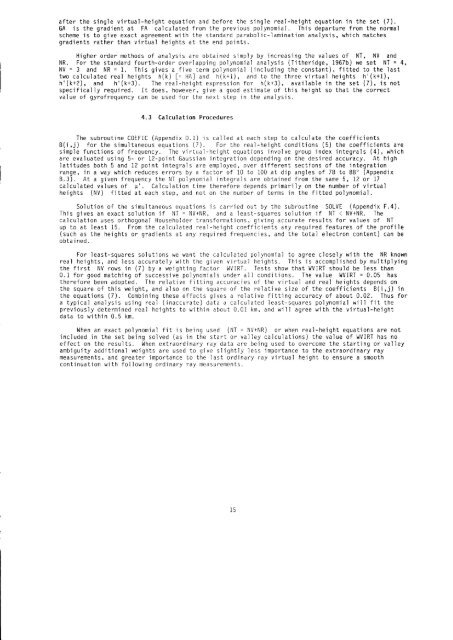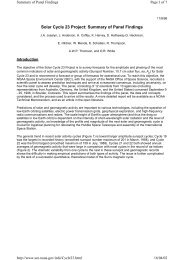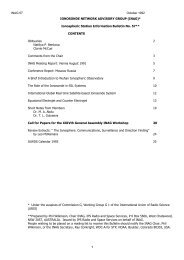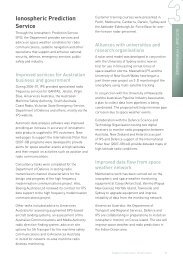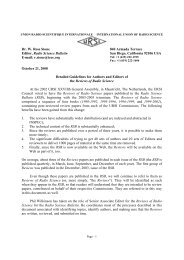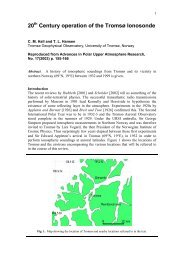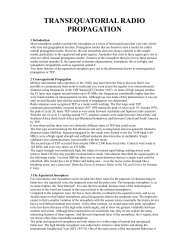UAG-93: Chapters 1 to 5 - URSI
UAG-93: Chapters 1 to 5 - URSI
UAG-93: Chapters 1 to 5 - URSI
You also want an ePaper? Increase the reach of your titles
YUMPU automatically turns print PDFs into web optimized ePapers that Google loves.
after the single virtual-height equation and before the single real-height equation in the set (7).<br />
GA is the gradient at FA calculated from the previous polynomial. This departure from the normal<br />
scheme is <strong>to</strong> g'ive exact agreement with the standarcj parabolic-lamjnation analysis, which matches<br />
gradients rather than virtual heights at the end points.<br />
Higher order methods of analysis are obtajned simply by increasing the values of NT, NV and<br />
NR. For the standard fourth-order overlapp'ing polynomial analysis (Titheridge, 1967b) we set NT = 4,<br />
NV = 3 and NR = 1. This gives a five term polynoniial (including the constant), fitted <strong>to</strong> the last<br />
two calculated real heights h(k) [= HA] and h(k+1), and <strong>to</strong> the three virtual heights h'(k+1),<br />
h'(k+2), and h'(k+:). The real*height expression for h(k+S), ava'ilable in the set (7), is not<br />
specifically required. It does, however, give a good estimate of this height so that the correct<br />
value of gyrofrequency can be used for the next step in the analysis.<br />
4.3 Calculation Procedures<br />
The subrout'ine C0EFIC (Appendix D.1) is called at each step <strong>to</strong> calculate the coefficients<br />
B(i,j) for the simultaneous equations (.7). For the real-height conditions (5) the coefficients are<br />
simple functions of frequency. The virtual-height equatjons involve group index integrals (4), which<br />
are evaluated using 5- or 12-point Gaussjan integration depend'ing on the desired accuracy. At high<br />
latitudes both 5 and 12 point'integrals are employed, over different sections of the integration<br />
range, 'in a way which reduces errors by a fac<strong>to</strong>r of i0 <strong>to</strong> 100 at d'ip angles of 78 <strong>to</strong> 88' (Appendix<br />
8.3). At a given frequency the NT polynomial integrals are obtained from the same 5, 12 or 17<br />
calculated values of U'. Calculatjon time therefore depends primarily on the number of virtual<br />
heights (NV) fitted at each step, and not on the number of terms in the fitted polynomial.<br />
Solution of the simultaneous equations js carried out by the subroutine S0LVE (Appendix F.4).<br />
This gives an exact solution if NT = NV+NR, and a least-square solution'if NT < NV+NR. The<br />
calculation uses orthogonal Householder transformations, giving accurate results for values of NT<br />
up <strong>to</strong> at least 15. From the calculated real-height coefficients any required features of the profile<br />
(such as the heights or gradients at any required frequencies, and the <strong>to</strong>tal electron content) can be<br />
obta i ned .<br />
For least-squares solutions we want the calculated polynomial <strong>to</strong> agree closely with the NR known<br />
real heights, and less accurately w.ith the given virtual heights. This is accomplished by multiplying<br />
the first NV rows in (7) by a weighting fac<strong>to</strong>r WVIRT. Tests show that WVIRT should be less than<br />
0.1 for good matching of successive polynomials under all conditions. The value WVIRT = 0.05 has<br />
therefore been adopted. The relative fitting accuracies of the vjrtual and real heights depends on<br />
the square of this weight, and also on the square of the relative size of the coeffic'ients B(i,j) in<br />
the equations (7). Combining these effects gives a relative fitting accuracy of about 0.02. Thus for<br />
a typical analysis us'ing real (inaccurate) data a calculated least-squares polynomial will fit the<br />
previously determjned real heights <strong>to</strong> within about 0.01 km, and will agree with the virtual-height<br />
data <strong>to</strong> w'ithin 0.5 km.<br />
When an exact polynomial fit is bejng used (NT = NV+NR) or when real-height equations are not<br />
included in the set being solved (as in the start or va11ey calculations) the value of WVIRT has no<br />
effect on the results. When extraondinary ray data are bejng used <strong>to</strong> overcome the starting or va'l'ley<br />
ambiguity additiona'l weights are used <strong>to</strong> give slightly less importance <strong>to</strong> the extraordinary ray<br />
measurements, and greater importance <strong>to</strong> the last ordinary ray virtual height <strong>to</strong> ensure a smooth<br />
continuation with fol lowinq ordinary rav measurements.<br />
15


